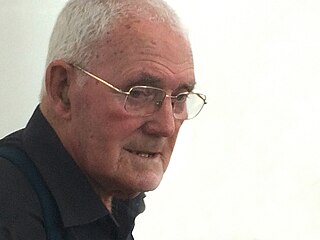
Nicolas Rex Smith is a New Zealand politician who served as a Member of Parliament (MP) for the National Party from 1990 to 2021. He served as a Cabinet minister, holding various posts including Minister for Building and Housing, Minister for the Environment, Minister for Climate Change Issues, and Minister of Local Government. For a brief time between October and November 2003 he was the deputy leader of the National Party, then in opposition under Don Brash.

Christchurch is the largest city in the South Island and the second-largest city by urban area population in New Zealand. Christchurch has an urban population of 415,100, and a metropolitan population of over half a million. It is located in the Canterbury Region, near the centre of the east coast of the South Island, east of the Canterbury Plains. It is located near the southern end of Pegasus Bay, and is bounded to the east by the Pacific Ocean and to the south by the ancient volcanic complex of the Banks Peninsula. The Avon River (Ōtākaro) winds through the centre of the city, with a large urban park along its banks. With the exception of the Port Hills, it is a relatively flat city, on an average around 20 m (66 ft) above sea level. Christchurch has a reputation for being an English city, with its architectural identity and nickname the 'Garden City' due to similarities with garden cities in England, but also has a historic Māori heritage. Christchurch has a temperate oceanic climate with regular moderate rainfall.

Aotea Square is a large paved public area in the CBD of Auckland, New Zealand. Officially opened in 1979 by Sir Dove-Myer Robinson next to Queen Street, it is used for open-air concerts and gatherings, markets, and political rallies. In November 2010, a major redevelopment of Aotea Square was completed. The square was redesigned to make it appropriate for use by crowds of up to 20,000 people.

The Christchurch Polytechnic Institute of Technology (CPIT), formerly the Christchurch Technical College, was an institute of technology in Christchurch, New Zealand. It merged with Aoraki Polytechnic and became Ara Institute of Canterbury in 2016.

Chris Booth is a New Zealand sculptor and practitioner of large-scale land art.

Michael Duncan Smither is a New Zealand painter and composer.

Feilding High School is a co-ed Secondary School in Feilding, New Zealand. It is the only secondary school in the town of Feilding.

The Hurunui River is the fourth largest of the four principal rivers in north Canterbury, New Zealand, with a catchment area of 2,670 square kilometres (1,030 sq mi). The river flows from the eastern side of the Southern Alps, to the Pacific Ocean.

Environment Canterbury, frequently abbreviated to ECan, is the promotional name for the Canterbury Regional Council. It is the regional council for Canterbury, the largest region in the South Island of New Zealand. It is part of New Zealand's structure of local government.

Eugenie Meryl Sage is a New Zealand environmentalist and former politician. She was a Green Party Member of Parliament in the New Zealand House of Representatives from 2011 to 2023.

Water pollution in Canterbury, New Zealand has become a major environmental issue, largely due to pollution from agricultural sources, but also industrial and urban sources.

The Citizens' War Memorial in Cathedral Square, Christchurch, is one of the two major memorials in the city to World War I. It is located immediately north of ChristChurch Cathedral. The annual Anzac Day service was held there until the February 2011 earthquake; since then the memorial has been behind the fence around the cathedral. It is a Category I heritage structure registered with Heritage New Zealand. Between 2021 and 2022, the memorial was repaired and shifted 50 metres (160 ft) to the west. The Citizens' War Memorial was used for the 2023 ANZAC day dawn service in Christchurch.

Rachel Elizabeth Boyack-Mayer is a New Zealand unionist and politician. Since 2020, she has been a Member of Parliament for the Labour Party.
Ria Bancroft was a British-New Zealand artist born in England. She created the Tabernacle Screen Doors for Cathedral of the Blessed Sacrament in Christchurch and her works are held in several New Zealand art galleries.

Avenal Beryl Elizabeth McKinnon was a New Zealand art historian and writer. She was the founding director of the New Zealand Portrait Gallery Te Pūkena Whakaata.
Marté Szirmay is a Hungarian New Zealand artist whose works are held in the collections of the Auckland Art Gallery Toi o Tāmaki and Museum of New Zealand Te Papa Tongarewa.
Charles Eldon Fayne Robinson is a New Zealand Māori artist specialising in carving. Robinson has contributed to the carving of buildings on many marae in New Zealand as well as exhibiting his art in galleries and museums.

Sculpture on the Gulf is a temporary outdoor art exhibition on a coastal headland on Matiatia Bay, Waiheke Island, New Zealand. It is a biennial event founded in 2003 by the Waiheke Community Art Gallery.

Barry Noel Thomas is a New Zealand artist and film maker. He is known for creating 1min art films called rADz and for his activism art including in the 1970s planting cabbages in an empty building site in Wellington City.

William Robert "Jim" Allen was a New Zealand visual artist. In 2015, he was named an Arts Foundation Icon by the Arts Foundation of New Zealand, an honour limited to 20 living people. Allen turned 100 years old in July 2022, and the occasion was marked by the Auckland Art Gallery with an exhibition of his works.

















